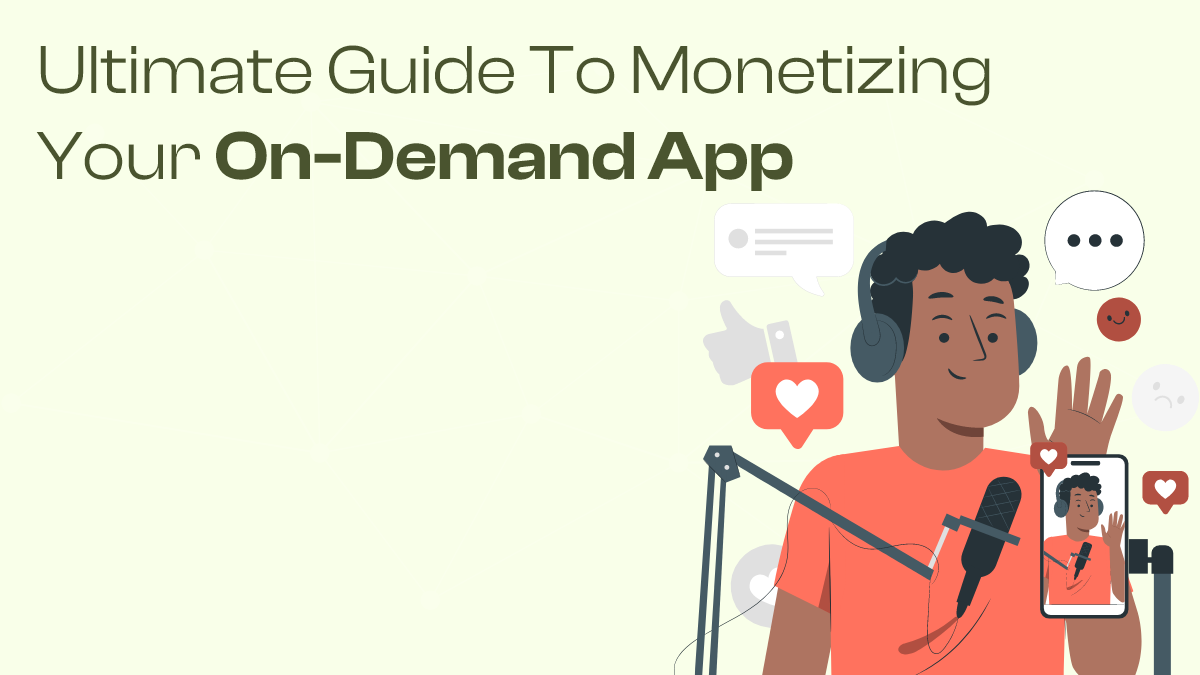In the competitive world of on-demand apps, developing a high-quality product is only the first step. To turn your app into a profitable business, you need a clear and effective monetization strategy. Whether you’re building a food delivery app, a ride-hailing service, or a healthcare platform, figuring out how to monetize your on-demand app is crucial to your long-term success.
In this ultimate guide, we’ll explore the various ways you can monetize your on-demand app, key strategies to implement, and tips to ensure consistent revenue growth.
Understanding the Basics of App Monetization
Why Monetization is Key for On-Demand Apps
Monetization is not just about generating revenue. It’s about sustaining your business model, enhancing customer experience, and fueling growth. Without a well-structured monetization strategy, even the most innovative on-demand apps may struggle to thrive in a competitive marketplace.
Monetization strategies are particularly important for on-demand apps because these apps often provide real-time services that incur operational costs, like logistics, payments, and customer support. Hence, striking a balance between user satisfaction and revenue generation is vital.
Setting the Foundation for Monetization
Before you can start earning revenue, it’s crucial to establish a strong foundation. This includes understanding your audience, identifying the value your app offers, and setting clear goals for revenue generation. You’ll need to answer key questions:
- Who are your users?
- What problem does your app solve?
- What are your competitors doing?
By thoroughly understanding your market, you can choose the best monetization model that works for your app and its users.
Common Monetization Models for On-Demand Apps
Subscription Model
One of the most popular methods to monetize an on-demand app is the subscription model. In this strategy, users pay a recurring fee—usually monthly or yearly—to access premium features or content. For example, apps offering exclusive benefits, faster delivery times, or premium content can charge users a subscription fee.
This model works well for apps that provide ongoing services or content, such as fitness, entertainment, or educational apps. The subscription model ensures steady and predictable revenue over time.
Freemium Approach
The freemium model is a variation of the subscription approach. It allows users to download and use the basic version of your app for free while offering premium features at a cost. This method is highly effective as it encourages a larger user base to try your app, and many free users eventually convert into paying customers once they see the value of premium features.
Commission-Based Model
For many on-demand service apps, the commission-based model is a go-to strategy. In this model, the app connects service providers with customers and takes a commission from each transaction. Uber, DoorDash, and many other service-based apps use this model, charging a percentage for each booking or transaction.
This is a win-win as users get the service they need, providers get more business, and the app generates revenue from the transactions happening on its platform.
Advertising
Advertising is another commonly used strategy, especially for apps that have a large user base but may not charge users directly. Apps can partner with brands and advertisers to show in-app ads, sponsored content, or product placements. The more users engage with your app, the more revenue you generate from advertisements.
Native Ads vs. Display Ads
- Native ads blend seamlessly into the app experience, providing value to the user while promoting a product or service.
- Display ads are traditional ads like banners or pop-ups that appear throughout the app.
While ads can be lucrative, it’s essential to balance the volume and placement so they don’t disrupt the user experience.
Transaction Fees
If your app processes payments between two parties—such as a marketplace for buying and selling goods—you can charge a transaction fee. Many apps add a small fee on top of the transaction amount when users make purchases, bookings, or exchanges. This model is often seen in eCommerce apps, ticketing services, and booking platforms.
In-App Purchases
In-app purchases are a significant revenue stream for many on-demand apps. They allow users to buy additional features, virtual goods, or upgrades directly within the app. This model is highly popular among gaming, entertainment, and fitness apps.
Examples of in-app purchases include:
- Virtual goods (e.g., game items or virtual currency)
- Premium content (e.g., exclusive access to videos or articles)
- App functionality upgrades (e.g., unlocking advanced features)
Choosing the Right Monetization Strategy for Your App
Analyze Your Target Audience
Choosing the right monetization strategy depends on understanding your target audience and their willingness to pay for your app’s services or features. For example, younger users may respond better to freemium models with in-app purchases, while professionals might prefer subscription-based premium content.
Evaluate Your App’s Value Proposition
Your app’s value proposition—what makes your app unique and useful—should drive your monetization strategy. If your app provides a high-value service like transportation or medical advice, users might be willing to pay for a subscription or accept transaction fees. On the other hand, apps that offer free or low-cost services may find better success with ads or in-app purchases.
Competitive Landscape
Take a look at how similar on-demand apps in your market are generating revenue. If your competitors are using a subscription model successfully, that might be a good option for your app. Conversely, if competitors are using ads or commission-based models, you might need to differentiate your app by offering a different approach.
Implementing and Optimizing Your Monetization Strategy
Testing and Experimentation
Once you’ve chosen a monetization strategy, it’s essential to test and refine your approach. Implement A/B testing to determine which features users are most willing to pay for and monitor user behavior to identify pain points in the payment process.
User Experience Comes First
Monetization should never come at the expense of the user experience. Ensure that any ads, subscriptions, or fees don’t interrupt the user’s journey within the app. For example, if you’re implementing ads, place them in a way that doesn’t feel intrusive. If you’re using the freemium model, offer real value in your free tier so users don’t feel pressured to upgrade.
Adjust and Scale
As your app grows, your monetization strategy should scale with it. You may want to introduce new revenue streams, such as additional premium features or higher-tier subscription plans. Always remain flexible and ready to adjust your strategy as the app evolves.
Conclusion
Creating a successful on-demand app is just the beginning of the journey—monetizing it effectively is what will sustain your business in the long term. Whether you opt for a subscription model, commission-based strategy, in-app purchases, or ads, the key to success lies in understanding your users and providing value that they’re willing to pay for.Unlock the secrets of monetizing your on-demand app with our Ultimate Guide! Learn expert tips and strategies from the leading on-demand app development company. Ultimately, the best strategy for monetizing your on-demand app is one that aligns with your goals, serves your users, and grows with your business.


